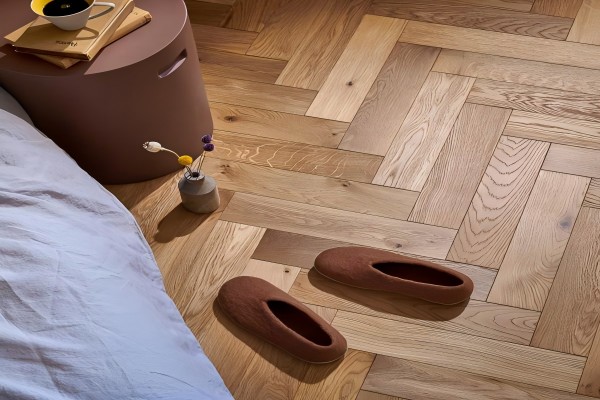Unlike traditional parquet flooring, which is made entirely from solid wood, engineered parquet flooring combines a top layer of solid wood with multiple layers of plywood or high-density fiberboard (HDF). This innovative construction offers many benefits, making it a preferred option for modern homes and commercial spaces.
Table of Contents
ToggleWhat is Engineered Parquet Flooring?
Engineered parquet flooring mimics the appearance of a traditional solid wood parquet but with a more stable and durable construction. The key difference lies in its structure. Engineered parquet consists of several layers, typically three to nine, of wood or wood-based materials.
Solid wood, typically oak, walnut, or maple, makes up the top layer, sometimes referred to as the wear layer, which gives the flooring its organic appearance and texture. Beneath this wear layer are layers of plywood or HDF, arranged in a cross-grain configuration to provide strength, stability, and resistance to changes in temperature and humidity.
This layered construction makes engineered parquet flooring more resilient to warping, cupping, and expansion compared to solid wood flooring. As a result, it is suitable for use in various environments, including basements, kitchens, and areas with underfloor heating.
What’s the Type of Engineered Parquet Flooring?
Engineered parquet flooring comes in various styles, patterns, and finishes, offering a wide range of options to suit different design preferences. Some of the most typical kinds are listed below:
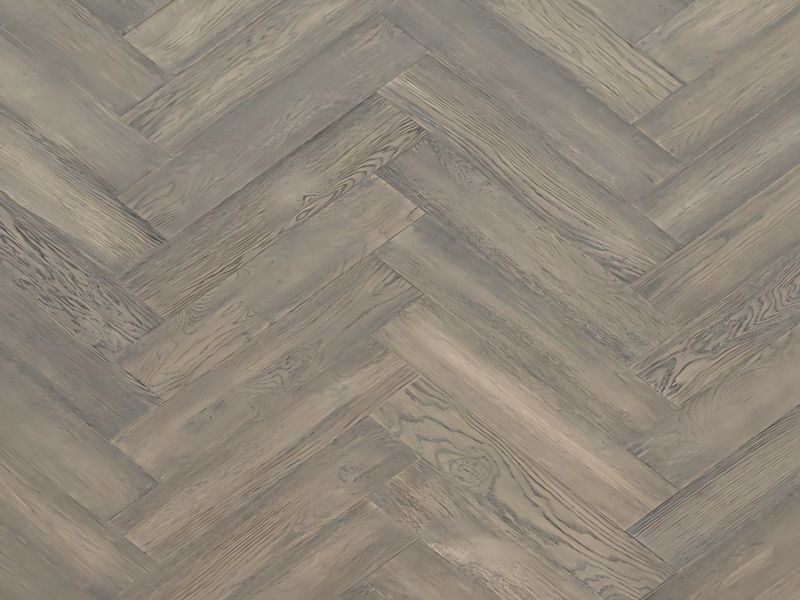
Herringbone
Herringbone is one of the most iconic and classic parquet patterns. It is made up of rectangular wood pieces that are 90 degrees apart from one another and placed in a zigzag pattern. Any area is made more elegant and gives a sense of movement by this pattern. Flooring with an engineered herringbone pattern is a common option for both classic and modern settings.
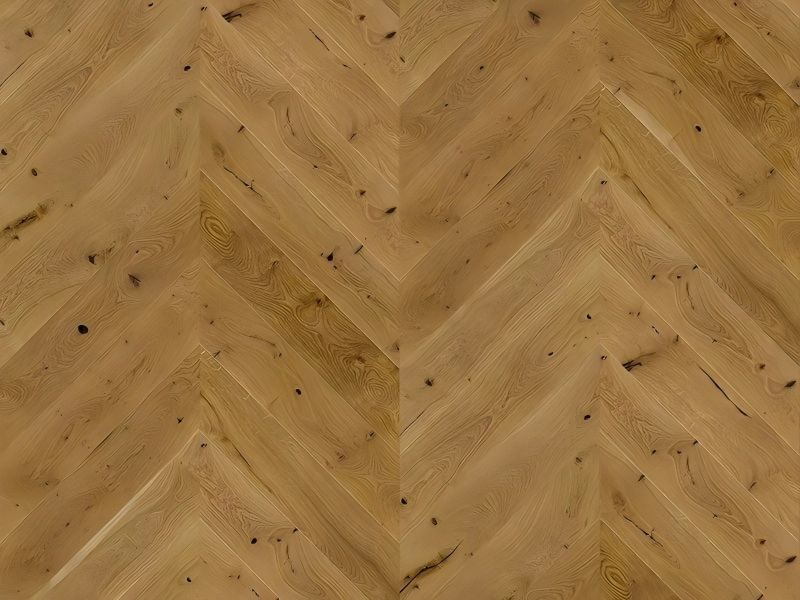
Chevron
The main distinction between herringbone and chevron parquet flooring is the angle at which the wood pieces’ ends are cut to form a continuous V-shaped pattern. This pattern is a popular option for modern homes since it provides a more streamlined and modern appearance. The flooring is more sophisticated and aesthetically pleasing due to the accuracy of the cut.
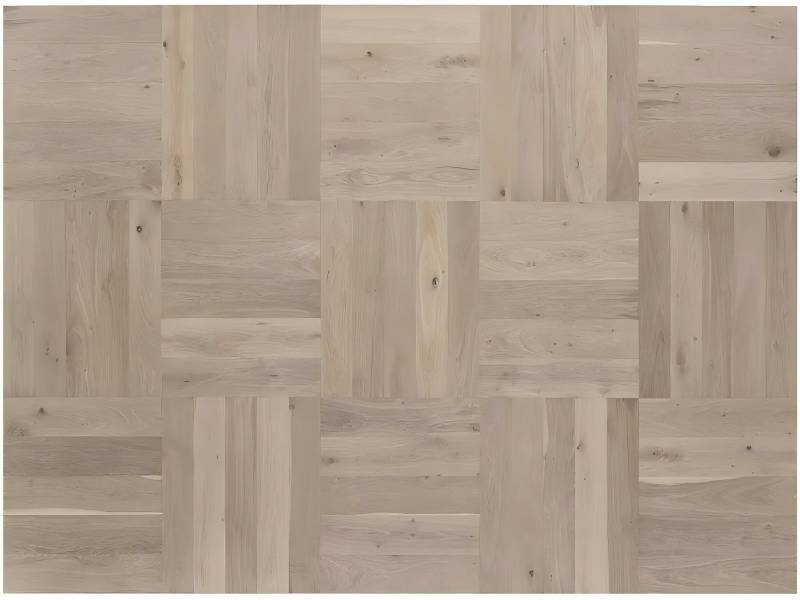
Basket Weave
Another classic parquet pattern is the basket weave pattern, which has wood planks arranged in a crisscross pattern to resemble a woven basket. This pattern gives a space a textured, detailed appearance that gives it more depth and personality. Engineered basket weave parquet flooring can be used to create a focal point in larger spaces, such as living rooms or dining areas.
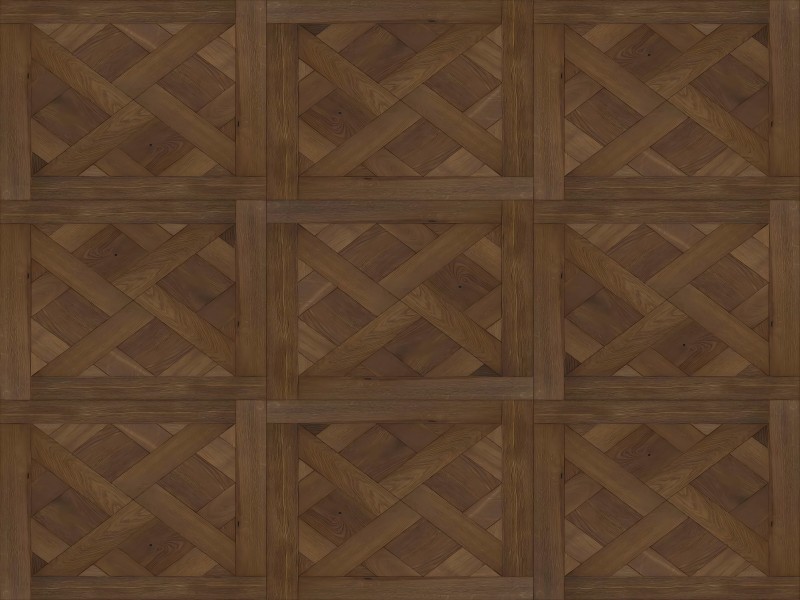
Versailles
The Versailles pattern is inspired by the intricate parquet flooring found in the Palace of Versailles in France. This pattern is made up of small, interlocking wood pieces arranged in a square, creating a complex and luxurious design. Engineered Versailles parquet flooring is often used in high-end residential and commercial spaces to create a sense of grandeur and opulence.
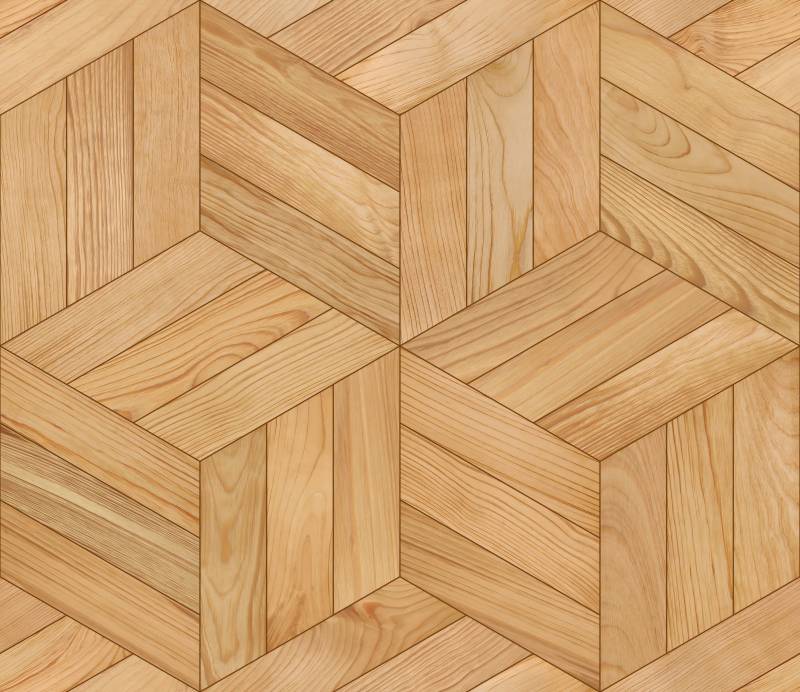
Custom parquet
Custom parquet engineered wood flooring combines intricate geometric patterns with the durability of engineered wood. Tailored to individual preferences, it offers a versatile and elegant aesthetic, suitable for various spaces while providing stability, moisture resistance, and ease of installation compared to traditional hardwood.
| Pattern | Visual Appeal | Difficulty of Installation | Cost Range per Sq Ft | Ideal for |
| Herringbone | Classic and elegant | Moderate | $4 – $12 | Both traditional and contemporary interiors |
| Chevron | Modern and streamlined | Moderate | $4 – $12 | Modern, minimalist spaces |
| Basket Weave | Textured and intricate | High | $8 – $15 | Larger rooms, focal points |
| Versailles | Luxurious and complex | High | $12 – $20+ | High-end, luxury spaces |
| Custom | Unique and personalized | Varies | Varies | Custom-designed interiors |
What are the Advantages and Disadvantages of Engineered Parquet Flooring?
The following benefits and drawbacks are listed for your reference:
Advantage:
- Aesthetic Appeal: Engineered parquet flooring provides the rich, timeless look of hardwood with the added benefit of intricate patterns. Because there are so many different designs to pick from, homeowners may select a look that goes well with their interior decor.
- Durability: Compared to solid wood, engineered parquet flooring is more resilient to temperature and humidity variations because of its multi-layered composition. Because of its longevity, it can be used in places like basements and rooms with underfloor heating where solid wood would not be appropriate.
- Ease of Installation: Compared to traditional parquet flooring, engineered parquet flooring is frequently simpler to install. Many engineered options come with click-and-lock systems, which simplify the installation process and reduce the need for nails or glue.
- Stability: The cross-grain construction of the plywood or HDF layers beneath the wear layer provides additional stability, reducing the risk of warping or cupping over time.
- Eco-Friendly: Engineered parquet flooring uses less solid wood than traditional parquet, making it a more sustainable choice. Additional steps are taken to lessen the environmental impact, such as using plywood or HDF, which can be constructed from quickly growing and renewable wood sources.
- Variety of Finishes: There are three different finishes for engineered parquet flooring: matte, semi-gloss, and high-gloss. With so many options, you may select a finish that complements both your own style and your level of care tolerance.
Refinishing: Engineered parquet flooring can be sanded and refinished once or twice throughout its lifetime, depending on the thickness of the wear layer, to prolong its longevity and preserve its look.
Disadvantages
- Cost: While generally more affordable than solid wood parquet, engineered parquet flooring can still be expensive, especially for high-quality options with thicker wear layers.
- Limited Refinishing: Unlike solid wood flooring, which can be sanded and refinished multiple times, engineered parquet flooring has a limited number of refinishing opportunities due to the thinner wear layer.
- Susceptible to Scratches: Even while engineered parquet flooring is sturdy, its top layer is nevertheless vulnerable to dents and scratches, particularly in high-traffic areas. Protective measures, such as using rugs and furniture pads, are recommended.
- Moisture Sensitivity: Even though engineered parquet flooring is more stable than solid wood, moisture still seeps through occasionally. Extended exposure to water can still result in damage, therefore it’s not as good for places like bathrooms that have a lot of moisture or humidity.
- Veneer Wear Layer: The thickness of the veneer wear layer varies among products, and lower-quality engineered parquet may have a very thin top layer that wears down quickly, reducing the floor’s longevity.
- Sound: Engineered parquet flooring can produce a hollow sound when walked on, particularly if not installed properly or if installed over an uneven subfloor. This can be mitigated with proper underlayment or soundproofing materials.
The Cost of Engineered Parquet Flooring
Engineered parquet flooring can have wide variations in price depending on several aspects such as wood species, wear layer thickness, pattern intricacy, and manufacturer. Below is a summary of what to anticipate:
Material Costs
- Basic Range: $4 to $8 per square foot. This range typically includes thinner wear layers (around 1-2 mm) and less expensive wood species like oak or maple. The patterns are usually simpler, such as herringbone or chevron.
- Mid-Range: $8 to $12 per square foot. Floors in this range feature thicker wear layers (around 3-4 mm), more complex patterns like Versailles or basket weave, and wood species like walnut or cherry.
- High-End Range: $12 to $20+ per square foot. High-end engineered parquet flooring includes thick wear layers (5 mm or more), exotic wood species like mahogany or teak, and custom patterns or finishes. These floors offer superior durability and a more luxurious appearance.
Installation Costs
- DIY Installation: If you choose to install the flooring yourself, the cost will primarily be the material cost and any tools or underlayment needed. However, engineered parquet flooring installation can be challenging, especially with complex patterns, so this option is best suited for those with experience.
- Professional Installation: Professional installation typically costs between $3 and $8 per square foot, depending on the complexity of the pattern and the region. Custom patterns and high-end flooring can push this cost higher.
Additional Costs
- Underlayment: Underlayment is essential for soundproofing, moisture protection, and ensuring a smooth installation. Based on the type and quality of the underlayment, the cost per square foot varies. It can be anywhere from $0.50 to $2.
- Finishing: If you opt for unfinished engineered parquet flooring, additional costs for staining, sealing, or applying a finish will be required. This may raise the overall cost by $2 to $5 per square foot.
- Maintenance: Over time, you may need to sand and refinish the flooring, especially in high-traffic areas. The cost for refinishing engineered parquet flooring ranges from $3 to $5 per square foot, depending on the condition and thickness of the wear layer.
| Category | Cost per Square Foot | Notes |
| Basic Range | $4 – $8 | Thinner wear layers (1-2 mm), less expensive wood like oak or maple |
| Mid-Range | $8 – $12 | Thicker wear layers (3-4 mm), more complex patterns like Versailles or basketweave |
| High-End Range | $12 – $20+ | Thick wear layers (5 mm+), exotic wood, custom patterns |
| DIY Installation | Material cost + tools/underlayment | Challenging installation, best for those with experience |
| Professional Installation | $3 – $8 | Cost varies by pattern complexity and region |
| Underlayment | $0.50 – $2 | Essential for soundproofing, moisture protection |
| Finishing | $2 – $5 | Additional cost for unfinished flooring |
| Maintenance | $3 – $5 | Refinishing cost over time |
Engineered Parquet Flooring Trends for 2024
Engineered parquet flooring continues to gain popularity as a versatile and stylish flooring option. In 2024, we see an evolution in both design and functionality, with trends catering to modern tastes, sustainability, and performance.
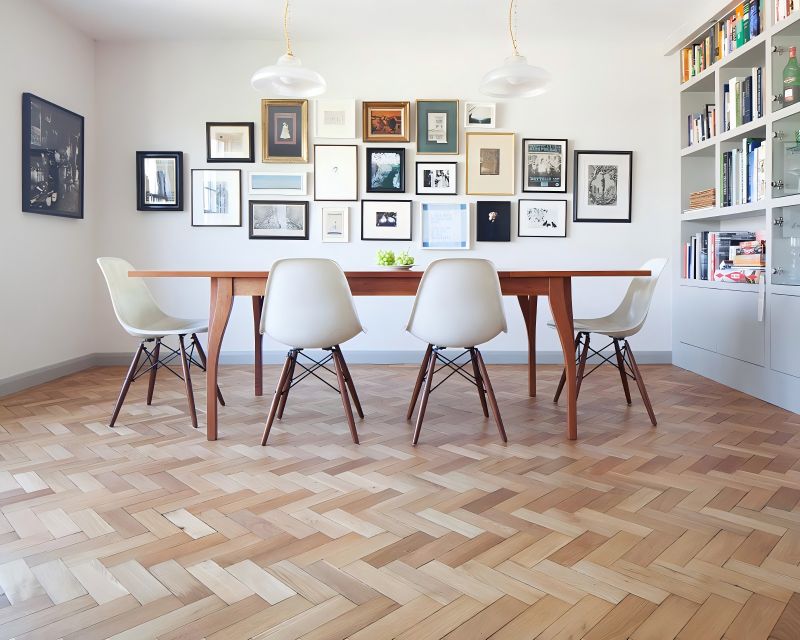
Natural Aesthetics
The trend toward natural aesthetics is gaining momentum in 2024, with a preference for lighter wood tones and organic finishes. Engineered parquet flooring that mimics the raw beauty of nature, with soft grains and neutral hues, is in demand. Oak, maple, and ash with light or matte finishes are popular choices, offering a timeless and airy appeal that works well in modern, minimalist interiors.
Large-Format Parquet Patterns
While traditional herringbone and chevron patterns remain classic, there’s a growing trend toward larger-format parquet patterns. In both residential and business settings, oversized boards and striking geometric shapes are creating a statement. These bigger patterns give an area an air of openness and have the power to turn a space into an artwork. Think of grand Versailles patterns or broad chevrons that add a contemporary edge to the timeless parquet style.
Mixed Media Designs
Another emerging trend for 2024 is the incorporation of mixed media in parquet flooring designs. Combining wood with materials such as metal, stone, or tile introduces a unique contrast that adds texture and depth to a space. Whether it’s a subtle metallic inlay or a bold stone border, mixed media parquet flooring offers a creative way to personalize interiors, bridging the gap between traditional craftsmanship and modern innovation.
Customized Parquet Flooring
Customization is becoming a major trend in 2024. Bespoke engineered parquet flooring solutions that are unique to each homeowner and designer are in high demand. Personalization is essential, from choosing particular wood species and finishes to creating unique patterns and arrangements. This trend allows for the creation of flooring that not only fits the aesthetic of the space but also stands out as a one-of-a-kind feature.
Multi-Tonal Parquet Designs
Multi-tonal parquet flooring is a bold trend that’s set to make waves in 2024. By blending different wood tones within a single pattern, this style adds visual interest and complexity to a space. Whether it’s subtle variations within the same color family or a striking mix of contrasting hues, multi-tonal parquet designs create a dynamic and visually engaging floor that can serve as the centerpiece of a room.
Smart Flooring Solutions
As technology continues to integrate into our daily lives, flooring is not exempt from innovation. Smart flooring alternatives such as underfloor heating systems are increasingly being paired with engineered parquet flooring. This trend combines comfort with energy efficiency, making homes cozier and more sustainable. Anticipate seeing more parquet flooring in 2024 with integrated elements that improve ease and usefulness.
Water-Resistant and High-Durability Options
Engineered parquet flooring is known for its durability, but 2024 brings a focus on enhanced water-resistant options. Many engineered parquet products are now more moisture resistant thanks to new treatments and technology, which makes them appropriate for basements, bathrooms, and kitchens. This trend expands the versatility of parquet flooring, allowing homeowners to enjoy its beauty in areas that traditionally might have required different materials.
Conclusion
Engineered parquet flooring, crafted by engineered wood flooring manufacturers, combines the elegance of traditional wood with modern durability, offering versatile design options and stability. While it has pros like ease of installation and eco-friendliness, it also has limitations, such as limited refinishing.

